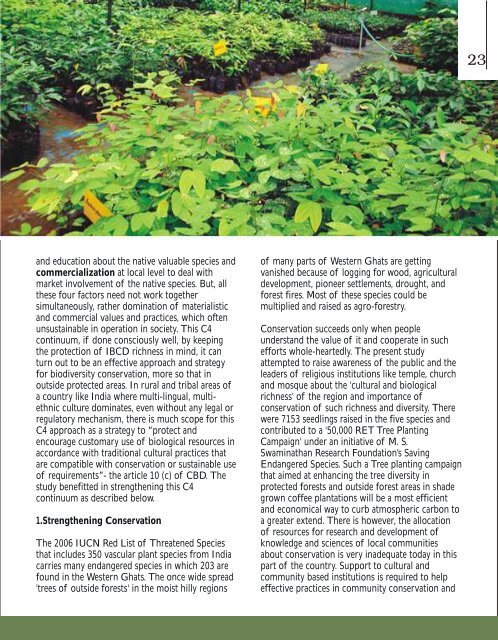Images - IUCN
Images - IUCN
Images - IUCN
Create successful ePaper yourself
Turn your PDF publications into a flip-book with our unique Google optimized e-Paper software.
and education about the native valuable species and<br />
commercialization at local level to deal with<br />
market involvement of the native species. But, all<br />
these four factors need not work together<br />
simultaneously, rather domination of materialistic<br />
and commercial values and practices, which often<br />
unsustainable in operation in society. This C4<br />
continuum, if done consciously well, by keeping<br />
the protection of IBCD richness in mind, it can<br />
turn out to be an effective approach and strategy<br />
for biodiversity conservation, more so that in<br />
outside protected areas. In rural and tribal areas of<br />
a country like India where multi-lingual, multiethnic<br />
culture dominates, even without any legal or<br />
regulatory mechanism, there is much scope for this<br />
C4 approach as a strategy to “protect and<br />
encourage customary use of biological resources in<br />
accordance with traditional cultural practices that<br />
are compatible with conservation or sustainable use<br />
of requirements”- the article 10 (c) of CBD. The<br />
study benefitted in strengthening this C4<br />
continuum as described below.<br />
1.Strengthening Conservation<br />
The 2006 <strong>IUCN</strong> Red List of Threatened Species<br />
that includes 350 vascular plant species from India<br />
carries many endangered species in which 203 are<br />
found in the Western Ghats. The once wide spread<br />
'trees of outside forests' in the moist hilly regions<br />
of many parts of Western Ghats are getting<br />
vanished because of logging for wood, agricultural<br />
development, pioneer settlements, drought, and<br />
forest fires. Most of these species could be<br />
multiplied and raised as agro-forestry.<br />
Conservation succeeds only when people<br />
understand the value of it and cooperate in such<br />
efforts whole-heartedly. The present study<br />
attempted to raise awareness of the public and the<br />
leaders of religious institutions like temple, church<br />
and mosque about the 'cultural and biological<br />
richness' of the region and importance of<br />
conservation of such richness and diversity. There<br />
were 7153 seedlings raised in the five species and<br />
contributed to a '50,000 RET Tree Planting<br />
Campaign' under an initiative of M. S.<br />
Swaminathan Research Foundation’s Saving<br />
Endangered Species. Such a Tree planting campaign<br />
that aimed at enhancing the tree diversity in<br />
protected forests and outside forest areas in shade<br />
grown coffee plantations will be a most efficient<br />
and economical way to curb atmospheric carbon to<br />
a greater extend. There is however, the allocation<br />
of resources for research and development of<br />
knowledge and sciences of local communities<br />
about conservation is very inadequate today in this<br />
part of the country. Support to cultural and<br />
community based institutions is required to help<br />
effective practices in community conservation and<br />
23

















